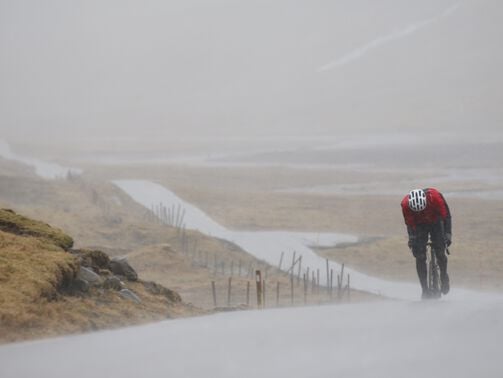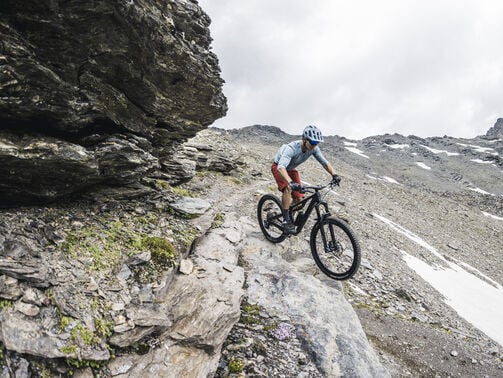19 Best MTB Gear and Accessories
Want to know the best MTB gear to take on your next ride on the trails? Check out our list of must-have accessories.

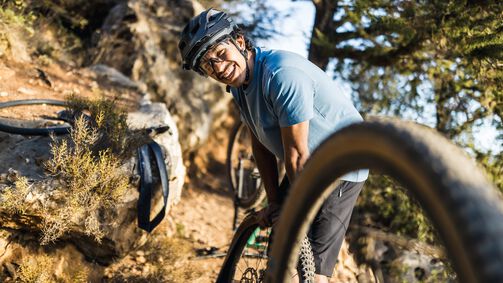
What’s the best mountain bike gear to get now you’ve got your mountain bike? Whether you’re new to the sport and are unsure what else you need to ride your new bike, or an experienced mountain biker who always forgets those few essentials, this list of the best mountain bike gear is for you.
Mountain biking by its nature is rough and ready, so you need to make sure you’re properly equipped for what’s coming up. Rocking up at the bike park or trail centre and realising you’ve forgotten some crucial bits of kit is not what you want. Time spent faffing around at the trail head is time spent not riding and that’s a huge no-no in our book.
It’s worth remembering that investing in good kit will pay off in the long run. You can’t put a price on good health and enjoying the great outdoors.
On that note, we reckon everything on this list will improve your experience of mountain biking:
Basic MTB Gear:
1. Helmet
2. Shoes
Must-Have MTB Gear:
3. Hydration
4. Protective glasses
5. Gloves
6. First-Aid Kit (you can never be too careful)
Repair Kit Essentials:
7. Spare tubes
8. Tyre levers
9. Hand pump or CO2 inflator
10. Multitool
Clothing for Mountain Biking:
11. Moisture-wicking top or cycling jersey
12. Cycling shorts, baggies or pants
13. Warm, weather-resistant jacket
14. Buff
Added Extras for Mountain Biking:
16. Bike lock
17. Bike lights
18. GPS computer
19. Snacks
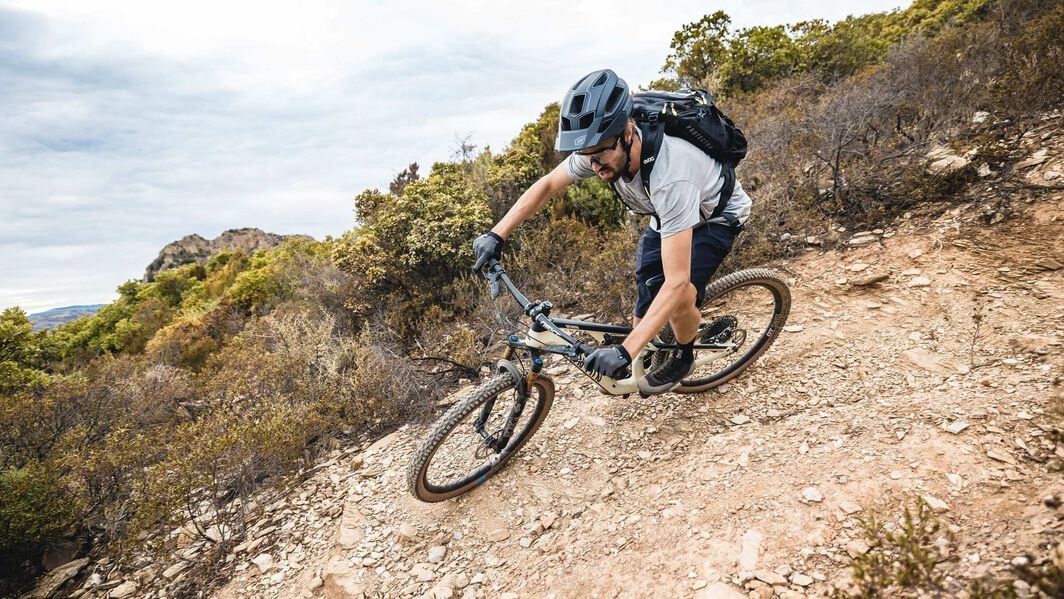
Basic MTB Gear:
If you’re going to get two things on this list, it has to be a helmet and shoes. Without either of these items, you’re going nowhere.
Mountain bike helmets come in two options: half face and full face. Half face helmets look like a conventional helmet but often come with a peak to keep the rain out of your face and away from your glasses. Full face helmets look similar to motorcycle helmets and offer more protection over really rough terrain. They’re mandatory in downhill mountain bike racing where the risk of crashing is greater.
If you’re starting out mountain biking on easy trails, a half face helmet will do the job nicely. If you’re taking on gnarly, steep terrain over rocks and roots, then a full face helmet will protect you if you come off your bike.
Whether you’re clipping in or using flat pedals, a good pair of mountain bike shoes is vital. Their superior grip and cleat compatibility offer the best comfort on the pedals.
Cross-country mountain bikers tend to use clipless pedals and shoes designed for good power transfer. Trail, enduro and downhill riders will often switch between flat pedals and clipless pedals depending on the trail conditions. Brands like Five Ten and Crankbrothers make comfortable trail shoes and are compatible with cleats if conditions suit.
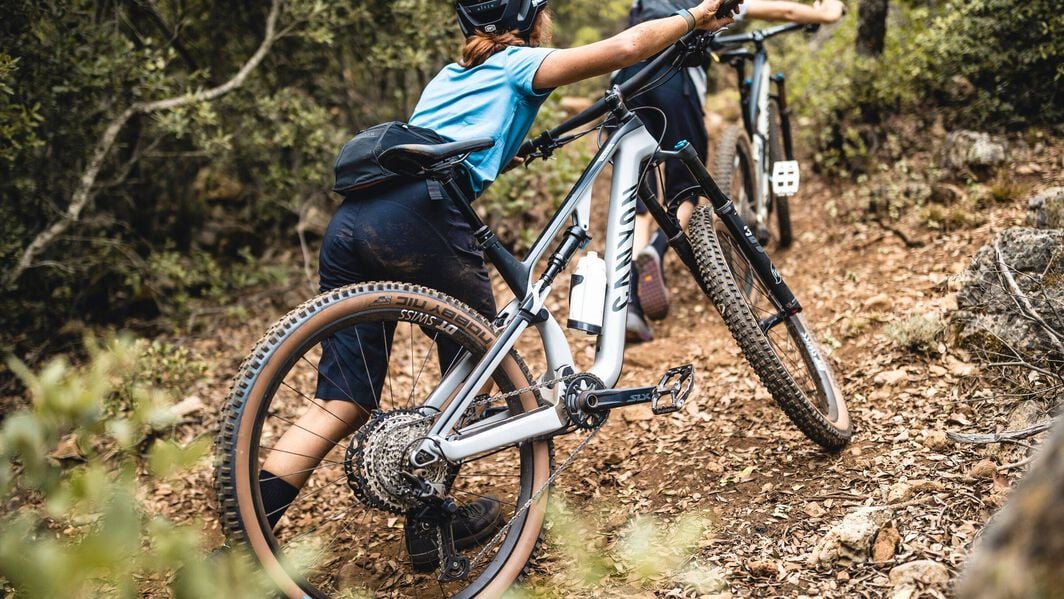
Must-Have MTB Gear:
Next on your shopping list should be these few items that will make mountain biking a little more comfortable and enjoyable. While you would get round without them, the chances are you’d have a much better time with a hydration pack or water bottles, glasses, gloves and a first-aid kit.
How you carry water on your bike is a balance of personal preference and practicality. If you ride a small full-suspension mountain bike, you might be better off carrying your water in a backpack or hip bag due to limited space in the frame.
Backpacks are great for riders who need to pack extra layers (for you and your mate who always forgets theirs), a lot of water and other luxuries like camera equipment. You can fit all this and your water in a relatively compact backpack with a bladder.
Due to the lack of a rear shock, hardtail mountain bikes have room for up to two water bottles. A more aggressive bike like a downhill mountain bike, may only have room for a smaller water bottle.
Hip bags are becoming increasingly popular for mountain bikers who only need room for the bare necessities. Some have small side pockets for stashing water bottles but if you can fit these in your frame, a lightweight hip bag is still a great option. You can keep a spare tube, CO2 canister and other small spares out of the way while you focus on shredding your hardest.
If it’s hot, carry more water than you think you require. Check the map for potential refill opportunities (shops, taps, streams) and carry a bit of cash just in case.
When you’re riding off-road, the chances are you’ll get dust, gravel, mud and all sorts of other surprises in your eyes while riding. The best way to protect your eyes against debris while mountain biking is by wearing glasses.
Not all glasses were created equally.
Light conditions matter when deciding which pair of riding glasses to get. Riding through the trees? You’ll be in the shade a lot, so you don’t want really dark lenses. Riding in gloomy weather? Choose lenses that brighten the features ahead on the trail.
If you ride with a full-face helmet, you should choose a pair of goggles that will fit over your helmet.
Eyes are precious, so it’s worth investing in high quality, protective eyewear to prevent any emergency trips to A&E.
Another crucial contact point with the bike is your hands. A good pair of MTB gloves will improve your grip on the handlebars and levers, protect your hands if you fall off and keep your fingers warm if it’s a little chilly.
Long-finger gloves generally provide the best protection, grip and warmth all in one package. Some gloves have minimal padding whereas others have gel or foam padding on the palm for extra comfort.
Whichever pair you choose, ensure you can safely control the bike and operate the brakes properly. The bulkier the glove, the less dexterous you’ll be on the brakes.
- Bandages
- Medical tape
- Wound dressings such as gauze and plasters
- Anti-septic wipes and sterile water to clean the wound
- Safety pins
- Ibuprofen and paracetamol
You never know what might happen out there. Scrapes, grazes and bruises are all part of the fun when you’re mountain biking. First aid kits are compact little safety nets for if it goes a bit wrong.
You can buy ready-made first aid kits or create your own. We recommend:
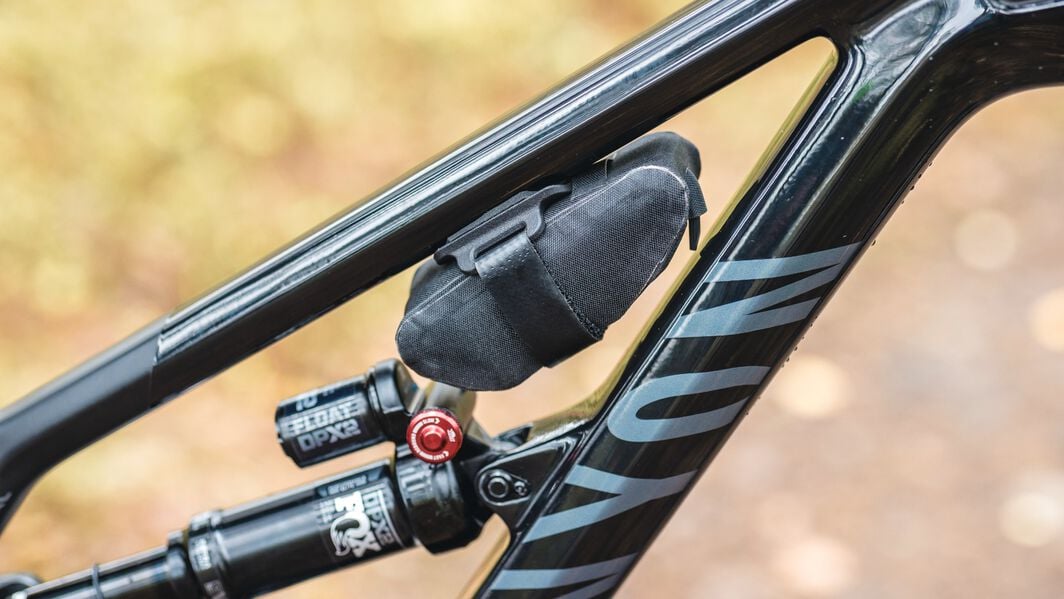
Repair Kit Essentials:
We’re no strangers to mechanicals and punctures. They happen to the best of us. One thing’s for sure: you can get back on the trails most of the time if you carry the right tools.
The obvious kit to carry is for puncture repair: spare tube, tyre levers and CO2 canister. This setup can be lightweight and can save you from being stranded a long way from home. A tubeless repair tool like a dynaplug can also be a useful addition to this kit if you don’t want to tube your wheel.
The other must-have tool in your kit is a multi-tool preferably with a chain-breaker. You never know if a couple of bolts are a little loose or if you need to make trail side repairs miles away from a fully-trained mechanic.
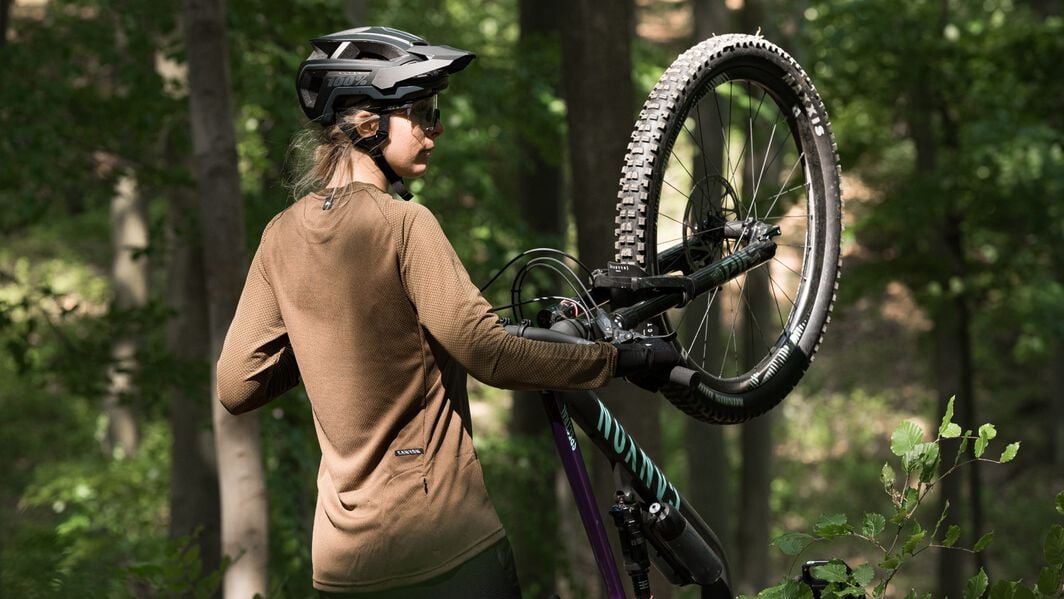
Clothing for Mountain Biking:
It’s important to be comfortable while you’re riding. The best way to do this is with proper mountain bike kit. Clothing makes a huge difference to how you feel on the bike and can make or break your desire for continuing.
Cross-country mountain bikers tend to wear lycra cycling jerseys due to the fast paced nature of the sport. Wear a suitable base layer for the time of year and you’ll be off to a flying start.
Trail, enduro and downhill riders tend to prefer something a bit more durable and loose-fitting. All hail the technical tee. These tops are made from a polyester, cotton and elastane blend to give superior comfort and quick-drying properties.
If your ride requires body armour, you’ll need a top that allows for the extra protection. Check the product information for guidance on how to size your kit.
Speed-demons of cross-country need all the aerodynamic clothing they can get to maintain high speeds on technical terrain. Lycra cycling shorts with a built-in chamois pad are perfect for this demanding sport.
For other mountain bikers who are likely to weave their way down tight trails and squelchy singletrack, more protection is required. Branches and thorns easily tear through lycra, so we recommend trail-specific mountain bike gear.
These garments are made with durability and comfort in mind. A pair of undershorts and baggy overshorts or mountain biking pants will buff away any rogue foliage in your way without issue. You’ll be able to fit knee pads underneath for added protection.
With great mountain biking comes great mountain weather. You can never be too sure of the forecast when heading out the door and it’s always best to be prepared for a spontaneous downpour.
Look for a cycling jacket that provides warmth and water-resistance. If the weather takes a turn for the worst, you’ll need a layer to stave off the chill while you descend back down to base camp.
Stash your jacket in your bag if you don’t need it when you set off. A lot of jackets pack down easily and are fairly lightweight.
When it’s cold, the last thing you want is a freezing face, ears or neck. A buff is such a lightweight bit of kit, we recommend grabbing one no matter what type of cycling you do. In the shoulder seasons, you can experience cool mornings and evenings, so you never know when you might need it.
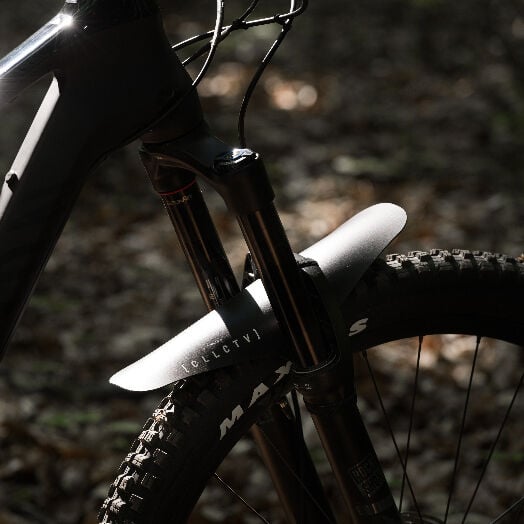
Added Extras for Mountain Biking:
These last few bits of gear are nice to have handy whenever you head out. While they’re not essential for getting out on your bike, they certainly provide good value.
A mudguard is a really handy piece of plastic that sits over your front wheel to prevent spray and mud hitting your face while you’re riding. It’s lightweight, easy to affix to your fork and really affordable - there’s really no reason not to get one!
If you haven’t had your own bike stolen, you will definitely know someone who has. It’s an awful reality of our lives but we can do our best to prevent it.
A small café lock is the least you can bring out for those few minutes you’re ordering some grub and a cuppa mid-ride. You never know who’s watching and an extra barrier could mean the difference between keeping your bike and ringing your bike insurance company.
Unless you’re purposely going out at night in the summer, you’re probably safe without lights. As you wander into autumn and winter though, you’ll probably benefit from a powerful light to show you the trail ahead.
Good mountain bike lights are extremely bright and rarely legal or recommended for use on the road. This is to highlight the features of the trail to keep you upright as you ride under the stars. Invest in a good front light and you’ll be set for year-round riding.
GPS computers have two benefits:
1. They store routes, so you know where you’re going
2. They record your ride, so you can look back later
If you’re new to mountain biking, you should check out online route platforms like Komoot for ideas of where to ride. If you like the sound of some routes, download them to your computer and follow the arrows.
When you get home, upload your ride to Strava and take a look at data such as elevation, total distance and average speed. Strava is a great training tool if you want to improve your performance and it’s also a nice way of looking back at where you’ve been over the years.
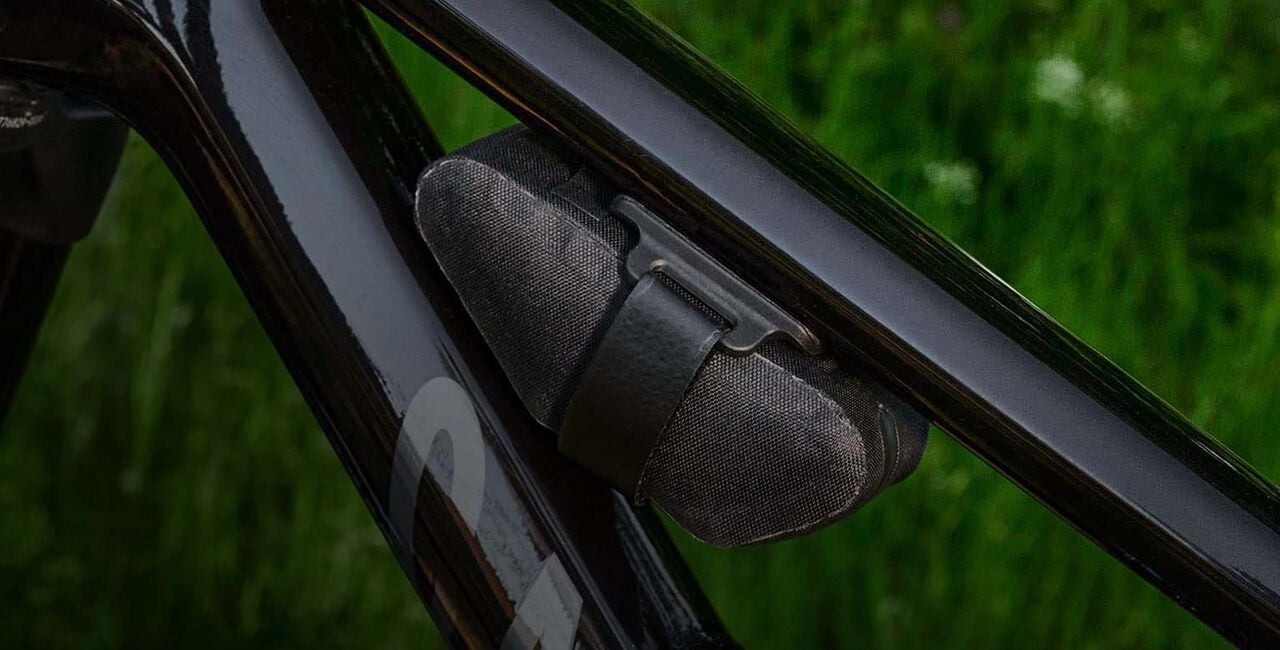
Browse our MTB gear collections
Did this article help?
Thank you for your feedback
